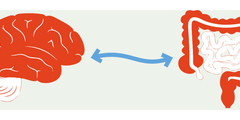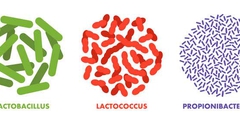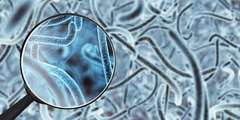
Voor de hersen-darm-ashypothese van ADHD lijkt er een mogelijke relatie te bestaan tussen het darmmicrobioom en ADHD. Kleinschalig onderzoek toont aan dat er aanwijzingen zijn dat personen met ADHD een andere samenstelling van het darmmicrobioom hebben.
Beste bezoeker, u heeft geen toegang.
Enkel (web)abonnees hebben toegang tot tijdschriftartikelen. Het webabonnement is nog in de maak.
U kunt zich wel alvast (gratis) registreren en tal van andere webartikelen raadplegen!
Trefwoorden:
Verschenen in
Referenties
Amiri, S., Malek, A., Sadegfard, M., & Abdi, S. (2012). Pregnancy-related maternal risk factors of attention-deficit hyperactivity disorder: a case-control study. ISRN pediatrics, 2012.
Arnold, L. E., Hurt, E., & Lofthouse, N. (2013). Attention-deficit/hyperactivity disorder: dietary and nutritional treatments. Child and adolescent psychiatric clinics of North America, 22(3), 381-402.
Bajaj, J. S., Ridlon, J. M., Hylemon, P. B., Thacker, L. R., Heuman, D. M., Smith, S., ... & Gillevet, P. M. (2012). Linkage of gut microbiome with cognition in hepatic encephalopathy. American Journal of Physiology-Gastrointestinal and Liver Physiology, 302(1), G168-G175.
Barkley, R. A. (1997). Behavioral inhibition, sustained attention, and executive functions: constructing a unifying theory of ADHD. Psychological bulletin, 121(1), 65.
Barkley, R. A., Fischer, M., Smallish, L., & Fletcher, K. (2006). Young adult outcome of hyperactive children: adaptive functioning in major life activities. Journal of the American Academy of Child & Adolescent Psychiatry, 45(2), 192-202.
Bercik, P., & Collins, S. M. (2014). The effects of inflammation, infection and antibiotics on the microbiota-gut-brain axis. In microbial endocrinology: the microbiota-gut-brain axis in health and disease (pp. 279-289). Springer New York.
Beydoun, H., & Saftlas, A. F. (2008). Physical and mental health outcomes of prenatal maternal stress in human and animal studies: a review of recent evidence. Paediatric and perinatal epidemiology, 22(5), 438-466.
Biederman, J., Monuteaux, M. C., Spencer, T., Wilens, T. E., & Faraone, S. V. (2009). Do stimulants protect against psychiatric disorders in youth with ADHD? A 10-year follow-up study. Pediatrics, 124(1), 71-78.
Blackman, J. A., & Conaway, M. R. (2012). Changes over time in reducing developmental and behavioral comorbidities of asthma in children. Journal of Developmental & Behavioral Pediatrics, 33(1), 24-31.
Bora, E., & Pantelis, C. (2016). Meta-analysis of social cognition in attention- deficit/hyperactivity disorder (ADHD): comparison with healthy controls and autistic spectrum disorder. Psychological medicine, 46(04), 699-716.
Borre, Y. E., O’Keeffe, G. W., Clarke, G., Stanton, C., Dinan, T. G., & Cryan, J. F. (2014). Microbiota and neurodevelopmental windows: implications for brain disorders. Trends in molecular medicine, 20(9), 509-518.
Brahmbhatt, K., Hilty, D. M., Hah, M., Han, J., Angkustsiri, K., & Schweitzer, J. B. (2016). Diagnosis and treatment of attention deficit hyperactivity disorder during adolescence in the primary care setting: a concise review. Journal of Adolescent Health, 59(2), 135-143.
Caillies, S., Bertot, V., Motte, J., Raynaud, C., & Abely, M. (2014). Social cognition in ADHD: irony understanding and recursive theory of mind. Research in developmental disabilities, 35(11), 3191-3198.
Cerdó, T., García-Valdés, L., Altmäe, S., Ruíz, A., Suárez, A., & Campoy, C. (2016). Role of microbiota function during early life on child's neurodevelopment. Trends in Food Science & Technology, 57, 273-288.
Chida, Y., Hamer, M., & Steptoe, A. (2008). A bidirectional relationship between psychosocial factors and atopic disorders: a systematic review and meta-analysis. Psychosomatic Medicine, 70(1), 102-116.
Coghill, D. R., Seth, S., Pedroso, S., Usala, T., Currie, J., & Gagliano, A. (2014). Effects of methylphenidate on cognitive functions in children and adolescents with attention-deficit/hyperactivity disorder: evidence from a systematic review and a meta-analysis. Biological psychiatry, 76(8), 603-615.
Cortese, S., Ferrin, M., Brandeis, D., Buitelaar, J., Daley, D., Dittmann, R. W., ... & Zuddas, A. (2015). Cognitive training for attention-deficit/hyperactivity disorder: meta- analysis of clinical and neuropsychological outcomes from randomized controlled trials. Journal of the American Academy of Child & Adolescent Psychiatry, 54(3), 164-174.
Cryan, J. F., & Dinan, T. G. (2012). Mind-altering microorganisms: the impact of the gut microbiota on brain and behaviour. Nature reviews neuroscience, 13(10), 701-712.
Curran, E. A., O'neill, S. M., Cryan, J. F., Kenny, L. C., Dinan, T. G., Khashan, A. S., & Kearney, P. M. (2015). Research review: birth by caesarean section and development of autism spectrum disorder and attention‐deficit/ hyperactivity disorder: a systematic review and meta‐analysis. Journal of Child Psychology and Psychiatry, 56(5), 500-508.
Das, D., Cherbuin, N., Anstey, K. J., & Easteal, S. (2015). ADHD symptoms and cognitive abilities in the midlife cohort of the PATH Through Life study. Journal of attention disorders, 19(5), 414-424.
Daulatzai, M. A. (2014). Obesity and gut’s dysbiosis promote neuroinflammation, cognitive impairment, and vulnerability to Alzheimer’s disease: new directions and therapeutic implications. J Mol Genet Med S, 1, 5.
Dinan, T. G., Stilling, R. M., Stanton, C., & Cryan, J. F. (2015). Collective unconscious: how gut microbes shape human behavior. Journal of psychiatric research, 63, 1-9.
Egger J, Graham PJ, Carter CM, Gumley D, Soothill JF (1985) Controlled trial of oligo- antigenic treatment in hyperkinetic syndrome. Lancet 325:540–545
El-Ansary, A., Shaker, G., & Rizk, M. (2013). Role of gut-brain axis in the aetiology of neurodevelopmental disorders with reference to autism. J. Clin. Toxicol. S, 6, 2161-0495.
Esparham, A., Evans, R. G., Wagner, L. E., & Drisko, J. A. (2014). Pediatric integrative medicine approaches to attention deficit hyperactivity disorder (ADHD). Children, 1(2), 186-207.
Faraone, S. V., Biederman, J., & Mick, E. (2006). The age-dependent decline of attention deficit hyperactivity disorder: a meta-analysis of follow-up studies. Psychological medicine, 36(02), 159-165.
Farhud, D., & Shalileh, M. (2014). Relation between Omega 3 Fatty Acid, Iron, Zinc and Treatment of ADHD. Zahedan Journal of Research in Medical Sciences, 16(8), 1-5.
Fond, G., Boukouaci, W., Chevalier, G., Regnault, A., Eberl, G., Hamdani, N., ... & Oliveira, J. (2015). The “psychomicrobiotic”: Targeting microbiota in major psychiatric disorders: A systematic review. Pathologie Biologie, 63(1), 35-42.
Foster, J. A., Lyte, M., Meyer, E., & Cryan, J. F. (2016). Gut microbiota and brain function: an evolving field in neuroscience. International Journal of Neuropsychopharmacology, 19(5), pyv114.
Friedrich, M. J. (2015). Unraveling the Influence of Gut Microbes on the Mind. Journal of the American Medical Association, 313, 1699-1701. doi:10.1001/jama.2015.2159
Fröhlich, E. E., Farzi, A., Mayerhofer, R., Reichmann, F., Jačan, A., Wagner, B., ... & Kashofer, K. (2016). Cognitive impairment by antibiotic-induced gut dysbiosis: analysis of gut microbiota-brain communication. Brain, behavior, and immunity, 56, 140-155.
Fuermaier, A. B., Tucha, L., de Vries, S. M., Koerts, J., van Heuvelen, M. J., van der Zee, E. A., & Tucha, O. (2016). Whole body vibration als nieuwe behandeling voor cognitieve dysfuncties bij ADHD?. Neuropraxis, 20(1), 34-42.
Gareau, M. G. (2014). Microbiota-gut-brain axis and cognitive function. In Microbial Endocrinology: The Microbiota-Gut-Brain Axis in Health and Disease (pp. 357-371). Springer New York.
Gibson, B. S., Gondoli, D. M., Ralph, K. J., & Sztybel, P. (2016). Application of the dual- component model of working memory to ADHD: Greater secondary memory deficit despite confounded cognitive differences. Child Neuropsychology, 1-21.
Guarner, F., & Malagelada, J. R. (2003). Gut flora in health and disease. The Lancet, 361(9356), 512-519.
Hawkey, E., & Nigg, J. T. (2014). Omega− 3 fatty acid and ADHD: Blood level analysis and meta-analyticextension of supplementation trials. Clinical psychology review, 34(6), 496-505.
Heijtz, R. D., Wang, S., Anuar, F., Qian, Y., Björkholm, B., Samuelsson, A., ... & Pettersson, S. (2011). Normal gut microbiota modulates brain development and behavior. Proceedings of the National Academy of Sciences, 108(7), 3047-3052.
Hodgson, K., Hutchinson, A. D., & Denson, L. (2014). Nonpharmacological treatments for ADHD: a meta-analytic review. Journal of attention disorders, 18(4), 275-282.
Hsiao, E. Y., McBride, S. W., Hsien, S., Sharon, G., Hyde, E. R., McCue, T., ... & Patterson, P. H. (2013). Microbiota modulate behavioral and physiological abnormalities associated with neurodevelopmental disorders. Cell, 155(7), 1451-1463.
van Hulst, B. M., de Zeeuw, P., & Durston, S. (2015). Distinct neuropsychological profiles within ADHD: a latent class analysis of cognitive control, reward sensitivity and timing. Psychological Medicine, 45(04), 735-745.
Kamada, N. & Nunez, G., (2014). Regulation of the immune system by the resident intestinal bacteria. Gastroenterology, 146, 1477-1488.
Kennedy, P. J., Murphy, A. B., Cryan, J. F., Ross, P. R., Dinan, T. G., & Stanton, C. (2016). Microbiome in brain function and mental health. Trends in Food Science & Technology, 57, 289-301.
Kennedy, P. J., Clarke, G., Quigley, E. M., Groeger, J. A., Dinan, T. G., & Cryan, J. F. (2012). Gut memories: towards a cognitive neurobiology of irritable bowel syndrome. Neuroscience & Biobehavioral Reviews, 36(1), 310-340.
Le, H. H., Hodgkins, P., Postma, M. J., Kahle, J., Sikirica, V., Setyawan, J., ... & Doshi, J. A. (2014). Economic impact of childhood/adolescent ADHD in a European setting: the Netherlands as a reference case. European child & adolescent psychiatry, 23(7), 587-598.
Luczynski, P., Neufeld, K. A. M., Oriach, C. S., Clarke, G., Dinan, T. G., & Cryan, J. F. (2016). Growing up in a bubble: using germ-free animals to assess the influence of the gut microbiota on brain and behavior. International Journal of Neuropsychopharmacology, 19(8), pyw020.
Minocha, A. (2009). Probiotics for preventive health. Nutrition in Clinical Practice, 24(2), 227-241.
Nigg, J. T., & Holton, K. (2014). Restriction and elimination diets in ADHD treatment. Child and adolescent psychiatric clinics of North America, 23(4), 937-953.
O’Mahony, S. M., Clarke, G., Dinan, T. G., & Cryan, J. F. (2017). Early-life adversity and brain development: Is the microbiome a missing piece of the puzzle?. Neuroscience, 342, 37-54.
Pärtty, A., Kalliomäki, M., Wacklin, P., Salminen, S., & Isolauri, E. (2015). A possible link between early probiotic intervention and the risk of neuropsychiatric disorders later in childhood: a randomized trial. Pediatric research, 77(6), 823-828.
Petra, A.I., Panagiotidou, S., Hatziagelaki, E., Stewart, J. M., Conti, P., & Theoharides, T. C. (2015). Gut-microbiota-brain axis and its effect on neuropsychiatric disorders with suspected immune dysregulation. Clinical therapeutics, 37(5), 984-995.
Pelsser, L. M., & Buitelaar, J. K. (2002). Favourable effect of a standard elimination diet on the behavior of young children with attention deficit hyperactivity disorder (ADHD): a pilot study. Nederlands tijdschrift voor geneeskunde, 146(52), 2543-2547.
Pelsser, L. M., Frankena, K., Toorman, J., Savelkoul, H. F., Dubois, A. E., Pereira, R. R., ... & Buitelaar, J. K. (2011). Effects of a restricted elimination diet on the behaviour of children with attention-deficit hyperactivity disorder (INCA study): a randomised controlled trial. The Lancet, 377(9764), 494-503.
Pelsser, L. M., Frankena, K., Toorman, J., & Pereira, R. R. (2017). Diet and ADHD, Reviewing the Evidence: A Systematic Review of Meta-Analyses of Double-Blind Placebo-Controlled Trials Evaluating the Efficacy of Diet Interventions on the Behavior of Children with ADHD. PLoS One, 12(1), e0169277.
Proctor, C., Thiennimitr, P., Chattipakorn, N., & Chattipakorn, S. C. (2017). Diet, gut microbiota and cognition. Metabolic Brain Disease, 32(1), 1-17.
Rogers, G. B., Keating, D. J., Young, R. L., Wong, M. L., Licinio, J., & Wesselingh, S. (2016). From gut dysbiosis to altered brain function and mental illness: mechanisms and pathways. Molecular psychiatry, 21(6), 738-748.
Romijn, A. R., & Rucklidge, J. J. (2015). Systematic review of evidence to support the theory of psychobiotics. Nutrition reviews, 73(10), 675-693.
Sandhu, K. V., Sherwin, E., Schellekens, H., Stanton, C., Dinan, T. G., & Cryan, J. F. (2017). Feeding the microbiota-gut-brain axis: diet, microbiome, and neuropsychiatry. Translational Research, 179, 223-244.
Schab, D. W., & Trinh, N. H. T. (2004). Do artificial food colors promote hyperactivity in children with hyperactive syndromes? A meta-analysis of double-blind placebo-controlled trials. Journal of Developmental & Behavioral Pediatrics, 25(6), 423-434.
Seymour, K. E., Mostofsky, S. H., & Rosch, K. S. (2016). Cognitive load differentially impacts response control in girls and boys with ADHD. Journal of abnormal child psychology, 44(1), 141-154.
Sherwin, E., Rea, K., Dinan, T. G., & Cryan, J. F. (2016). A gut (microbiome) feeling about the brain. Current opinion in gastroenterology, 32(2), 96-102.
Sibley, M. H., Kuriyan, A. B., Evans, S. W., Waxmonsky, J. G., & Smith, B. H. (2014). Pharmacological and psychosocial treatments for adolescents with ADHD: An updated systematic review of the literature. Clinical Psychology Review, 34(3), 218-232.
Singh, A., Yeh, C. J., Verma, N., & Das, A. K. (2015). Overview of attention deficit hyperactivity disorder in young children. Health Psychology Research, 3(2).
Sonuga-Barke, E. J. (2002). Psychological heterogeneity in AD/HD—a dual pathway model of behaviour and cognition. Behavioural brain research, 130(1), 29-36.
Sonuga-Barke, E., Bitsakou, P., & Thompson, M. (2010). Beyond the dual pathway model: evidence for the dissociation of timing, inhibitory, and delay-related impairments in attention-deficit/hyperactivity disorder. Journal of the American Academy of Child & Adolescent Psychiatry, 49(4), 345-355.
Sonuga-Barke, E. J., Brandeis, D., Cortese, S., Daley, D., Ferrin, M., Holtmann, M., ... & Dittmann, R. W. (2013). Nonpharmacological interventions for ADHD: systematic review and meta-analyses of randomized controlled trials of dietary and psychological treatments. American Journal of Psychiatry, 170(3), 275-289.
Sonuga‐Barke, E. J., & Coghill, D. (2014). The foundations of next generation attention‐deficit/hyperactivity disorder neuropsychology: building on progress during the last 30 years. Journal of Child Psychology and Psychiatry, 55(12), e1-e5.
Tarver, J., Daley, D., & Sayal, K. (2014). Attention‐deficit hyperactivity disorder (ADHD): an updated review of the essential facts. Child: care, health and development, 40(6), 762- 774.
Tamminga, H. G., & Geurts, H. M. (2016). Is er een typisch neuropsychologisch profiel bij volwassenen met ADHD? Een ontwikkelingsperspectief. Neuropraxis, 20(1), 11-19.
Thapar, A., Cooper, M., Eyre, O. & Langley, K. (2013) Practitioner Review: what have we learnt about the causes of ADHD? Journal of Child Psychology and Psychiatry, 54, 3– 16.
Thapar, A., & Cooper, M. (2016). Attention deficit hyperactivity disorder. Lancet, 19;387, 1240-50. doi: 10.1016/S0140-6736(15)00238-X. Epub 2015 Sep 17.
Theije, C. G., Bavelaar, B. M., Lopes da Silva, S., Korte, S. M., Olivier, B., Garssen, J., & Kraneveld, A. D. (2014). Food allergy and food‐based therapies in neurodevelopmental disorders. Pediatric Allergy and Immunology, 25(3), 218-226.
Torrente, F., López, P., Prado, D. A., Kichic, R., Cetkovich-Bakmas, M., Lischinsky, A., & Manes, F. (2014). Dysfunctional Cognitions and their Emotional, Behavioral, and Functional Correlates in Adults with Attention Deficit Hyperactivity Disorder (ADHD) Is the Cognitive-Behavioral Model Valid?. Journal of attention disorders, 18(5), 412-424.
Umbrello, G., & Esposito, S. (2016). Microbiota and neurologic diseases: potential effects of probiotics. Journal of translational medicine, 14(1), 298.
Verlaet, A. A., Noriega, D. B., Hermans, N., & Savelkoul, H. F. (2014). Nutrition, immunological mechanisms and dietary immunomodulation in ADHD. European child & adolescent psychiatry, 23(7), 519-529.
Wang, H. X., & Wang, Y. P. (2016). Gut Microbiota-brain Axis. Chinese Medical Journal, 129(19), 2373.





